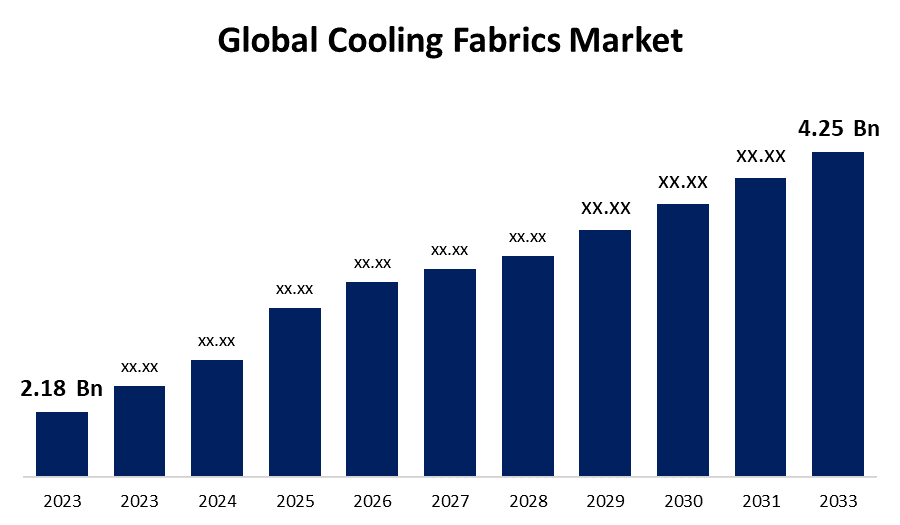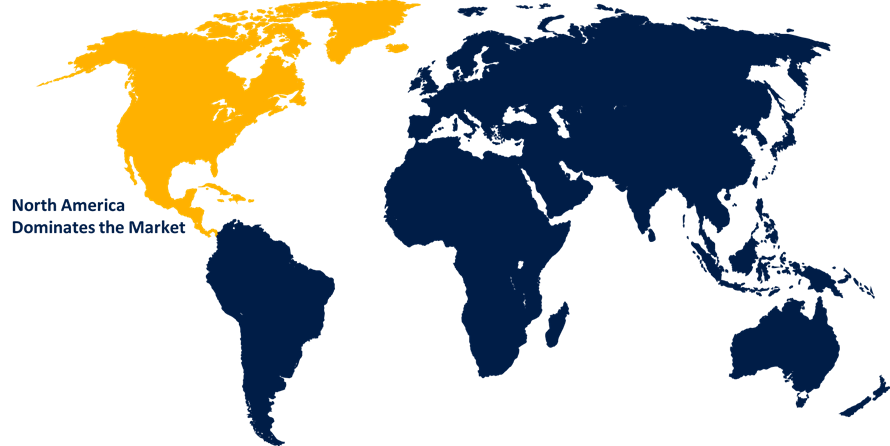Global Cooling Fabrics Market Size, Share, and COVID-19 Impact Analysis, By Type (Natural, and Synthetic), By Textile Type (Woven, Nonwoven, and Knitted), By Application (Sports Apparel, Lifestyle, and Protective Wearing), and By Region (North America, Europe, Asia-Pacific, Latin America, Middle East, and Africa), Analysis and Forecast 2023 - 2033
Industry: Chemicals & MaterialsGlobal Cooling Fabrics Market Size Insights Forecasts to 2033
- The Global Cooling Fabrics Market Size was Valued at USD 2.18 Billion in 2023.
- The Market Size is Growing at a CAGR of 6.90% From 2023 to 2033.
- The Worldwide Cooling Fabrics Market Size is Expected to Reach USD 4.25 Billion by 2033.
- Asia Pacific Expected to Grow the Fastest during the Forecast period.

Get more details on this report -
The Global Cooling Fabrics Market Size is Anticipated to Exceed USD 4.25 Billion by 2033, Growing at a CAGR of 6.90% from 2023 to 2033.
Market Overview
Cooling fabrics are innovative substances that control body heat and provide the wearer with a cooling sensation. They are sometimes referred to as temperature-regulating textiles or smart textiles. These textiles use a variety of technologies, including moisture-wicking technologies, phase-change materials, and thermal radiation manipulation, to accomplish their cooling qualities. By actively controlling body temperature, wicking away moisture, and improving air circulation, cooling materials aim to improve comfort in heated settings or during physical activity. The basis for cooling fabrics is the scientific idea of heat transmission. The three basic ways that the human body loses heat are radiation, convection, and conduction. These methods are applied by cooling textiles to enhance the body's inherent cooling capabilities. Moisture-wicking is an important concept. Modern materials hasten evaporation, which draws sweat away from the skin and cools the body. Phase change materials (PCMs), which absorb and release heat during their solid-to-liquid transition, are also included in certain cooling textiles. These endothermic and exothermic reactions help to better regulate and soothe the body's tissue. Furthermore, more effective cooling fabric technologies have been developed as a result of developments in materials science and textile engineering, which have spurred innovation and increased the market's potential. The market for cooling textiles is expected to rise further as people become more aware of how temperature affects their well-being.
Report Coverage
This research report categorizes the market for the global cooling fabrics market based on various segments and regions forecasts revenue growth and analyzes trends in each submarket. The report analyses the key growth drivers, opportunities, and challenges influencing the global cooling fabrics market. Recent market developments and competitive strategies such as expansion, product launch, and development, partnership, merger, and acquisition have been included to draw the competitive landscape in the market. The report strategically identifies and profiles the key market players and analyses their core competencies in each sub-segment of the global cooling fabrics market.
Cooling Fabrics Market Report Coverage
| Report Coverage | Details |
|---|---|
| Base Year: | 2023 |
| Market Size in 2023: | USD 2.18 Billion |
| Forecast Period: | 2023-2033 |
| Forecast Period CAGR 2023-2033 : | 6.90% |
| 2033 Value Projection: | USD 4.25 Billion |
| Historical Data for: | 2019-2022 |
| No. of Pages: | 200 |
| Tables, Charts & Figures: | 120 |
| Segments covered: | By Type, By Textile Type, By Application, By Region, and COVID-19 Impact Analysis |
| Companies covered:: | Coolcore LLC, Nanostitch, Ahlstrom-Munksjö, NILIT Ltd., Nan Ya Plastics Corporation, Asahi Kasei Advanced Corporation, Formosa Taffeta Co. Ltd., Tex-Ray Industrial Co. Ltd., Polartec, Hexarmor, and |
| Pitfalls & Challenges: | COVID-19 Empact,Challenges, Future, Growth, & Analysis |
Get more details on this report -
Driving Factors
Government support is becoming more and more crucial for leading a healthier lifestyle and engaging in sports. Additionally, nations want to promote an active lifestyle via developing young talent, which will have several positive effects. The cooling textiles business will advance as a result. The number of sporting events taking place globally is predicted to rise, which will encourage more people to take up different sports and boost the market for cooling textiles as well as sports fabrics. The need for greater performance and wellness is a major reason driving the market for cooling fabrics. Individuals who engage in strenuous physical activities, including athletes and fitness enthusiasts, are becoming increasingly conscious of the significance of clothes in preserving a suitable body temperature during exercise. Cooling fabrics let athletes compete at their peak for longer periods by minimizing heat-related fatigue and illness. As a result, the global cooling fabrics market is growing faster due to these considerations.
Restraining Factors
Because of its high price, the product is based on consumer desire and is out of reach for middle-class consumers. The product's high cost is mostly attributable to its intensive research and development. The cost of the finished product is further increased by elements like the usage of raw materials of the highest caliber and the need for sophisticated production infrastructure. Furthermore, a lack of consumer knowledge about the innovative and cooling fabrics market will have a major impact on market expansion.
Market Segmentation
The Global Cooling Fabrics Market share is classified into type, textile type, application
- The synthetic segment is expected to hold the largest share of the global cooling fabrics market during the forecast period.
Based on the type, the global cooling fabrics market is divided into natural, and synthetic. Among these, the synthetic segment is expected to hold the largest share of the cooling fabrics market during the forecast period. This is because synthetic cooling fabrics are designed to dissipate heat quickly and efficiently, they are perfect for athletes, physically active people, and energetic folks. Moisture-wicking qualities included in synthetic cooling textiles help to keep the skin dry and comfortable during exercises and outdoor activities by drawing perspiration away from the body. Additionally, rising utilization is expected to accelerate the synthetic segment growth in the global cooling fabrics market.
- The knitted segment is expected to grow at the fastest pace in the global cooling fabrics market during the forecast period.
Based on the textile type, the global cooling fabrics market is divided into woven, nonwoven, and knitted. Among these, the knitted segment is expected to grow at the greatest pace in the cooling fabrics market during the forecast period. This is due to the increasing popularity of athleisure styles, improvements in knitting technology, and the growing need for cozy sportswear. Knit cooling materials fit tight to the body and provide maximum ventilation and moisture wicking. Knit textiles' architecture makes it possible to improve their cooling properties by using a variety of cooling methods, like mesh panels, open-knit structures, and moisture-wicking fibers.
- The sports apparel segment is expected to grow at the greatest pace in the global cooling fabrics market during the forecast period.
Based on the application, the global cooling fabrics market is divided into sports apparel, lifestyle, and protective wearing. Among these, the sports apparel segment is expected to grow at the greatest pace in the cooling fabrics market during the forecast period. To improve the user's experience during physical activity, cooling fabrics are widely utilized in sportswear for athletes and active persons. They are made for particular sports, such as basketball, tennis, soccer, cycling, jogging, and more. These materials improve comfort, encourage ventilation, and help wick away perspiration so that athletes can concentrate on their performance. Additionally, rising utilization is expected to accelerate the sports apparel segment's growth in the global cooling fabrics market.
Regional Segment Analysis of the Global Cooling Fabrics Market
- North America (U.S., Canada, Mexico)
- Europe (Germany, France, U.K., Italy, Spain, Rest of Europe)
- Asia-Pacific (China, Japan, India, Rest of APAC)
- South America (Brazil and the Rest of South America)
- The Middle East and Africa (UAE, South Africa, Rest of MEA)
North America is anticipated to hold the largest share of the global cooling fabrics market over the predicted timeframe.

Get more details on this report -
North America is anticipated to hold the largest share of the global cooling fabrics market over the predicted timeframe. This is because there are a lot of large cooling fabric manufacturing enterprises in the area. In North America, the consumption of clothes, protective gear, and sportswear is rising. The region's love of sports and outdoor activities has created a strong need for textiles that are performance-oriented, particularly cooling textiles. To produce superior cooling textiles, there has been a surge in research and development in North America.
Asia Pacific is expected to grow at the fastest pace in the global cooling fabrics market during the forecast period. The growth is ascribed to many elements such as Growing consumer disposable income is predicted to drive up demand for cooling materials. Growing consumer demand for materials that regulate temperature and cozy apparel. improvements in cooling fabrics as a result of developments in textile technology. increasing knowledge of the advantages of cooling fabrics, including increased performance and comfort.
Competitive Analysis:
The report offers the appropriate analysis of the key organizations/companies involved within the global cooling fabrics along with a comparative evaluation primarily based on their product offering, business overviews, geographic presence, enterprise strategies, segment market share, and SWOT analysis. The report also provides an elaborative analysis focusing on the current news and developments of the companies, which includes product development, innovations, joint ventures, partnerships, mergers & acquisitions, strategic alliances, and others. This allows for the evaluation of the overall competition within the market.
List of Key Companies
- Coolcore LLC
- Nanostitch
- Ahlstrom-Munksjö
- NILIT Ltd.
- Nan Ya Plastics Corporation
- Asahi Kasei Advanced Corporation
- Formosa Taffeta Co. Ltd.
- Tex-Ray Industrial Co. Ltd.
- Polartec
- Hexarmor
Key Target Audience
- Market Players
- Investors
- End-users
- Government Authorities
- Consulting And Research Firm
- Venture capitalists
- Value-Added Resellers (VARs)
Recent Developments
- In March 2023, NILIT, which produces cooling fabrics under its main brand, SensE By Nature, was accredited by the International Sustainability and Carbon Certification Plus system (ISCC).
- In July 2022, Polartec LLC created the "Polartec Delta Ice" fabric, a novel cooling fabric technology. This fabric offers enhanced moisture management and cooling performance by combining cooling yarns with hydrophilic treatments. The technique was included in several sports equipment collections and provided sportsmen with enhanced cooling capacities during demanding workouts.
Market Segment
This study forecasts revenue at global, regional, and country levels from 2020 to 2033. Spherical Insights has segmented the Global Cooling Fabrics Market based on the below-mentioned segments:
Global Cooling Fabrics Market, By Type
- Natural
- Synthetic
Global Cooling Fabrics Market, By Textile Type
- Woven
- Nonwoven
- Knitted
Global Cooling Fabrics Market, By Application
- Sports Apparel
- Lifestyle
- Protective Wearing
Global Cooling Fabrics Market, By Region
- North America
- US
- Canada
- Mexico
- Europe
- Germany
- Uk
- France
- Italy
- Spain
- Russia
- Rest of Europe
- Asia Pacific
- China
- Japan
- India
- South Korea
- Australia
- Rest of Asia Pacific
- South America
- Brazil
- Argentina
- Rest of South America
- Middle East & Africa
- UAE
- Saudi Arabia
- Qatar
- South Africa
- Rest of the Middle East & Africa
Need help to buy this report?